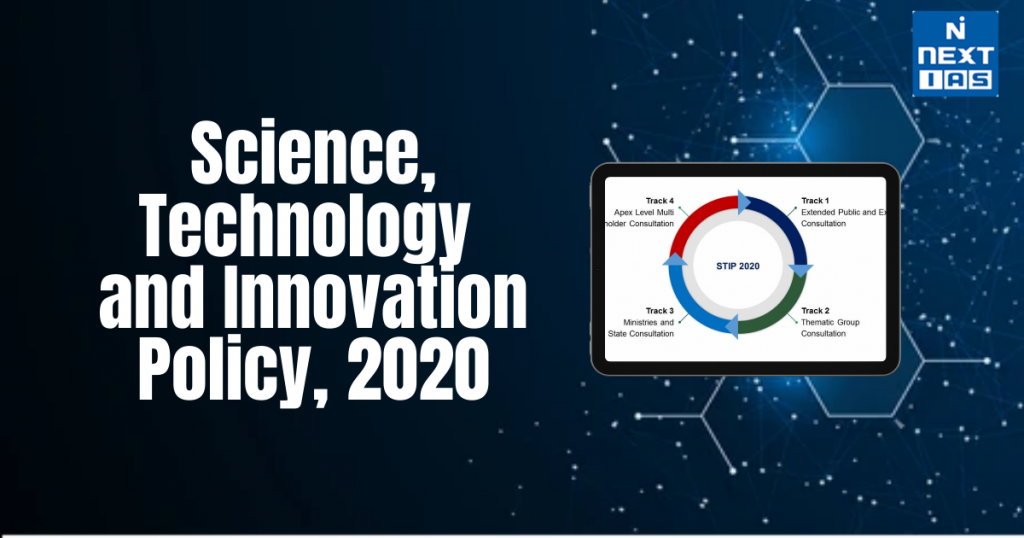
The Science, Technology, and Innovation Policy, 2020 aims to promote a vibrant ecosystem for scientific research and technological advancement in India. Its significance lies in fostering innovation-driven growth and addressing societal challenges through effective science and technology initiatives. This article aims to study in detail the key features, objectives, and implications of the policy for the future of science and technology in the country.
About Science, Technology, and Innovation Policy, 2020
The Science, Technology, and Innovation Policy (STIP) 2020 marks a significant milestone in India’s quest to enhance its scientific capabilities and technological prowess. Aimed at fostering a vibrant ecosystem for research and innovation, STIP 2020 is designed to propel India towards becoming a global leader in science and technology. This policy aligns with the nation’s overarching goals of economic development, social inclusion, and environmental sustainability.
Objectives of STIP 2020
The primary objectives of STIP 2020 are as follows:
- Enhancing Scientific Research: To boost the quality and quantity of scientific research, ensuring it addresses national challenges and global issues.
- Promoting Innovation: To create an environment that fosters innovation across sectors, encouraging collaboration between academia, industry, and government.
- Supporting Startups and Entrepreneurship: To facilitate the growth of startups and encourage entrepreneurial initiatives in science and technology.
- Encouraging Interdisciplinary Research: To promote interdisciplinary approaches that integrate various fields of study, addressing complex challenges more effectively.
- Strengthening Public-Private Partnerships: To build strong collaborations between the public and private sectors to drive innovation and commercialization of research outcomes.
Key Features of STIP 2020
- Inclusivity and Equity: STIP 2020 emphasizes inclusivity, ensuring that diverse voices are heard in the scientific community. It aims to promote participation from women, underrepresented groups, and marginalized communities in science and technology fields.
- Focus on Indigenous Technologies: The policy advocates for the development and promotion of indigenous technologies, encouraging research that is relevant to local needs and conditions. This approach aims to reduce dependency on foreign technologies and enhance self-reliance.
- National Research Foundation (NRF): STIP 2020 proposes the establishment of a National Research Foundation to provide overarching support for research funding, improve research infrastructure, and enhance collaboration between various research institutions.
- Digital Transformation: The policy recognizes the role of digital technologies in advancing scientific research and innovation. It encourages the adoption of digital tools and platforms to enhance research collaboration and data sharing.
- Sustainable Development Goals (SDGs): STIP 2020 aligns with the United Nations Sustainable Development Goals, ensuring that scientific research and technological advancements contribute to sustainable development and address pressing global challenges such as climate change, health, and poverty.
Implementation Strategies
To achieve the objectives outlined in STIP 2020, several implementation strategies are proposed:
- Capacity Building: Developing a skilled workforce through education and training programs that enhance capabilities in science, technology, and innovation.
- Funding Mechanisms: Establishing robust funding mechanisms to support research and innovation initiatives, including grants, loans, and venture capital for startups.
- Strengthening Institutions: Enhancing the capabilities of research institutions and universities to foster high-quality research output.
- Monitoring and Evaluation: Implementing a framework for monitoring and evaluating the impact of science and technology initiatives to ensure accountability and effectiveness.
Challenges and Future Directions
While STIP 2020 presents a comprehensive framework for advancing science and technology in India, several challenges remain. These include:
- Resource Allocation: Ensuring adequate funding and resources are allocated to support the policy’s ambitious goals.
- Infrastructure Development: Upgrading research infrastructure to meet the demands of modern scientific inquiry.
- Encouraging Collaboration: Fostering collaboration between academia, industry, and government, which is crucial for translating research into practical applications.
Conclusion
The Science, Technology, and Innovation Policy 2020 is a forward-looking framework to transform India’s scientific landscape. STIP 2020 seeks to create an ecosystem that supports sustainable development and economic growth by promoting research, innovation, and collaboration. As India navigates the complexities of the 21st century, successfully implementing this policy will be crucial in achieving its aspirations as a global leader in science and technology.
FAQs
What is science technology and innovation policy?
National Science Technology and Innovation Policy is a framework guiding research, technological development, and innovation to drive economic growth, societal well-being, and national competitiveness. It promotes scientific research, fosters technological advancements, and encourages innovation through regulations, funding, and strategic initiatives to address global challenges and enhance sustainable development.
What is the science technology and innovation policy 2013?
The Science, Technology, and Innovation (STI) Policy 2013 of India aimed to position the country among global leaders in research and innovation. It emphasized increasing R&D investment, fostering collaboration, promoting indigenous technology, enhancing science education, and leveraging innovation for inclusive growth, sustainability, and national socio-economic development.






